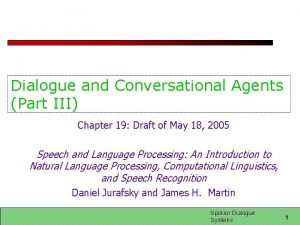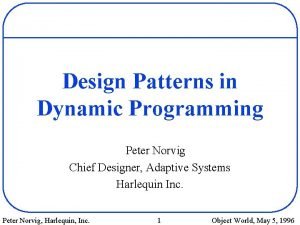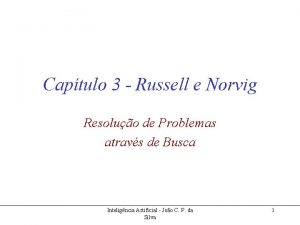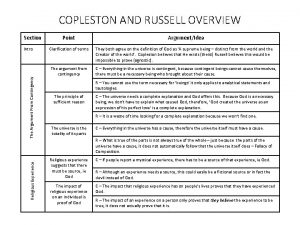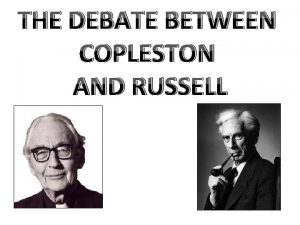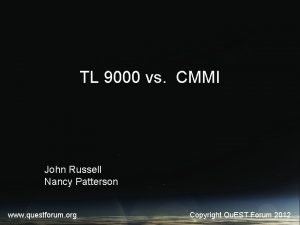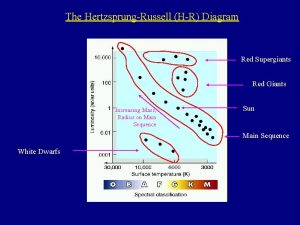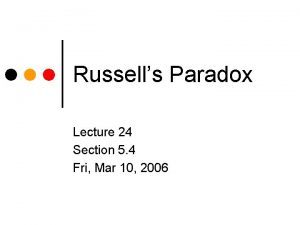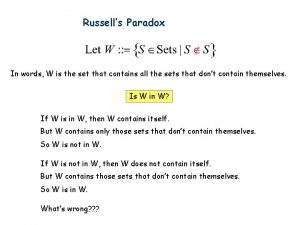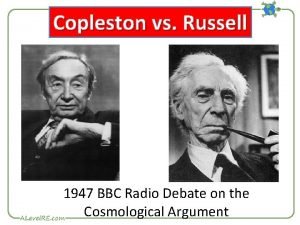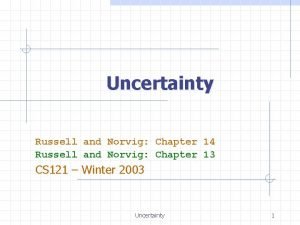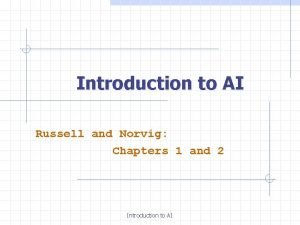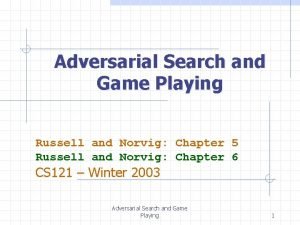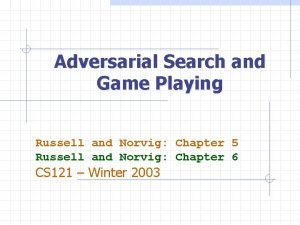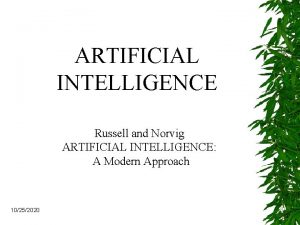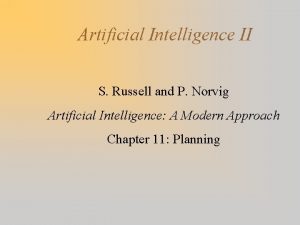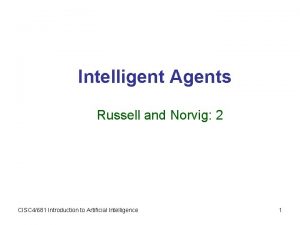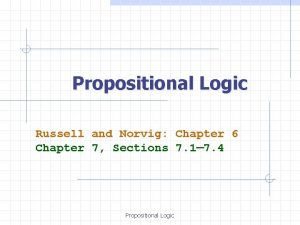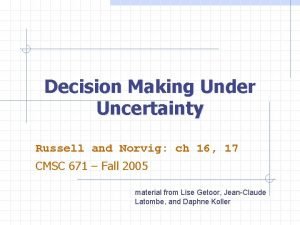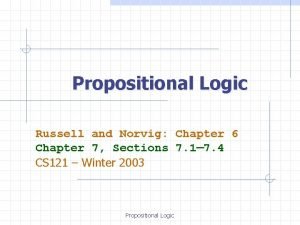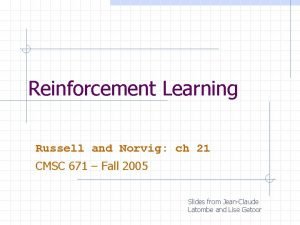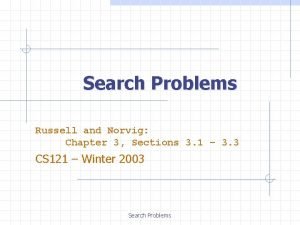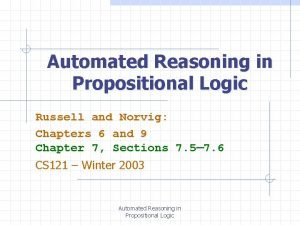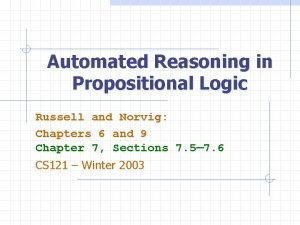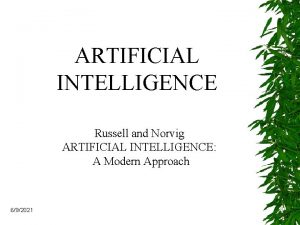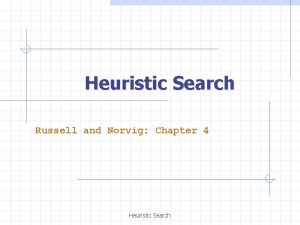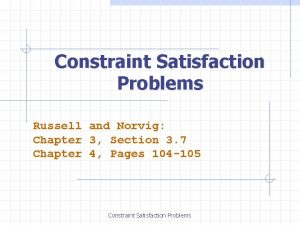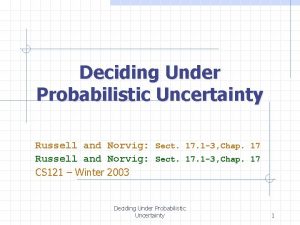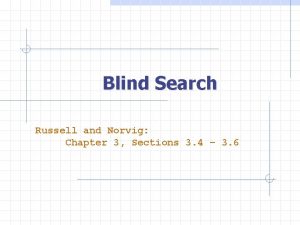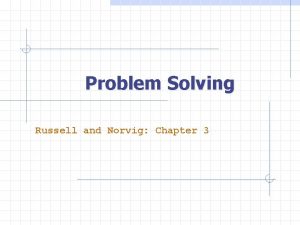Introduction to AI Russell and Norvig Chapters 1














































- Slides: 46

Introduction to AI Russell and Norvig: Chapters 1 and 2 Introduction to AI

Found on the Web … AI is the reproduction of the methods of Intelligent behavior human reasoning or intuition Computer Using computational models to simulate intelligent (human) behavior and processes AI is the study of mental faculties through the Humans use computational methods Introduction to AI 2

I personally think that AI started as a rebellion against some form of establishment telling us “Computers cannot perform certain tasks requiring intelligence” For example, for many years AI researchers have regarded computational complexity theory as irrelevant to their field. They eventually had to reckon with it, but in the meantime computational complexity had also changed a lot. Introduction to AI 3

What is AI? Discipline that systematizes and automates intellectual tasks to create machines that: Act like humans Act rationally Think like humans Think rationally Introduction to AI 4

Act Like Humans AI is the art of creating machines that perform functions that require intelligence when performed by humans Methodology: Take an intellectual task at which people are better and make a computer do it • Prove a theorem • Play chess Turing test • Plan a surgical operation • Diagnose a disease • Navigate in a building Introduction to AI 5

Chess Name: Garry Kasparov Title: World Chess Champion Crime: Valued greed over common sense Humans are still better at making up excuses. © Jonathan Schaeffer Introduction to AI 6

Perspective on Chess: Pro “Saying Deep Blue doesn’t really think about chess is like saying an airplane doesn't really fly because it doesn't flap its wings” Drew Mc. Dermott © Jonathan Schaeffer Introduction to AI 7


Perspective on Chess: Con “Chess is the Drosophila of artificial intelligence. However, computer chess has developed much as genetics might have if the geneticists had concentrated their efforts starting in 1910 on breeding racing Drosophila. We would have some science, but mainly we would have very fast fruit flies. ” John Mc. Carthy © Jonathan Schaeffer Introduction to AI 9

Think Like Humans How the computer performs functions does matter Comparison of the traces of the reasoning steps Cognitive science testable theories of the workings of the human mind But, do we want to duplicate human imperfections? Introduction to AI 10

Think/Act Rationally Always make the best decision given what is available (knowledge, time, resources) • Connection to economics, A performance measure operational is required research, and control theory n 객관적인가? 청소로봇, 보상(reward) 디자이너의 • Butn ignores role평가기준? of consciousness, emotions, n 자원의 제한이 있을 때? fear of dying on intelligence Perfect knowledge, unlimited resources logical reasoning Imperfect knowledge, limited resources (limited) rationality Introduction to AI 11

Bits of History 1956: The name “Artificial Intelligence” was coined. (Would “computational rationality” have been better? ) Early period (50’s to late 60’s): Basic principles and generality n n General problem solving Theorem proving Games Formal calculus Introduction to AI 12

Bits of History 1969 -1971: Shakey the robot (Fikes, Hart, Nilsson) Logic-based planning (STRIPS) Motion planning (visibility graph) Inductive learning (PLANEX) Computer vision Introduction to AI 13

Bits of History Knowledge-is-Power period (late 60’s to mid 80’s): n n Focus on narrow tasks require expertise Encoding of expertise in rule form: If: the car has off-highway tires and 4 -wheel drive and high ground clearance Then: the car can traverse difficult terrain (0. 8) n n n Knowledge engineering 5 th generation computer project CYC system (Lenat) Introduction to AI 14

Bits of History AI becomes an industry (80’s – present): n n n Expert systems: Digital Equipment, Teknowledge, Intellicorp, Du Pont, oil industry, … Lisp machines: LMI, Symbolics, … Constraint programming: ILOG Robotics: Machine Intelligence Corporation, Adept, GMF (Fanuc), ABB, … Speech understanding Introduction to AI 15

Bits of History The return of neural networks, genetic algorithms, and artificial life (80’s – 90’s) Increased connection with economics, operational research, and control theory (90’s – present) AI becomes less philosophical, more technical and mathematically oriented Introduction to AI 16

Predictions and Reality … (1/3) In the 60’s, a famous AI professor from MIT said: “At the end of the summer, we will have developed an electronic eye” As of 2002, there is still no general computer vision system capable of understanding complex dynamic scenes But computer systems routinely perform road traffic monitoring, facial recognition, some medical image analysis, part inspection, etc… Introduction to AI 17

Predictions and Reality … (2/3) In 1958, Herbert Simon (CMU) predicted that within 10 years a computer would be Chess champion This prediction became true in 1998 Today, computers have won over world champions in several games, including Checkers, Othello, and Chess, but still do not do well in Go Introduction to AI 18

Predictions and Reality … (3/3) In the 70’s, many believed that computer-controlled robots would soon be everywhere from manufacturing plants to home Today, some industries (automobile, electronics) are highly robotized, but home robots are still a thing of the future But robots have rolled on Mars, others are performing brain and heart surgery, and humanoid robots are operational and available for rent (see: http: //world. honda. com/news/2001/c 011112. html) Introduction to AI 19

Mistakes … Often, the potential of a new field is over-estimated in its early age, but under-estimated over the longer term AI proponents have over-estimated the need for smart software, and underestimated the feasibility and potential of large software systems based on massive coding effort Introduction to AI 20



인간과 다른 유인원 Introduction to AI 23

Sahelanthropus tchadensis 뇌의 진화과정 원인류 네안데르탈 인 Homo sapiens 1300 -1700 cc 600만 500만 400만 300만 유럽인 100만 200만 아프리카인 오스트랄로 피테쿠스 뇌용적 : 400 -500 cc Homo habilus (handy man) 600 -800 cc Homo erectus 동아시아인 800 -1200 cc 호주 원주민 Introduction to AI 24

뇌의 용량 Introduction to AI 25

인류의 진화 Introduction to AI 26

Human Brain Chimpanzee Brain Introduction to AI 27



언어의 진화 Introduction to AI 30

'Speech Gene' Tied to Modern Humans FOXP 2 gene - first identified by Monaco’s group at Oxford University (Science 2001) - 715 amino acids, two amino acid mutation in human lineage since 6 million years ago – fixed at 120, 000 – 200, 000 years ago (Svante Paabo, Nature 2002) Evolutionary leap. One of these primates is able to talk about what he's seeing; the other isn't. Introduction to AI 31



아인슈타인의 뇌 Introduction to AI 34




뇌의 특정 유전자 과도 발현하는 형질 전환 마우스 제조 (smart mice) T. V. P. BLISS et al. , Nature, 1999 transgenic mice overexpressing the NR 2 B subunit of the NMDA receptor Introduction to AI 38




Notion of an Agent sensors ? environment agent actuators laser range finder sonars Introduction to AI touch sensors 42

Notion of an Agent sensors ? environment agent actuators Introduction to AI 43

Notion of an Agent sensors ? environment agent actuators • Locality of sensors/actuators • Imperfect modeling • Time/resource constraints • Sequential interaction • Introduction Multi-agent worlds to AI 44

단순화한 인공지능 문제 에이전트의 조건 n n 성공을 평가한 판단기준 환경 또는 응용영역에 대한 사전지식 Agent가 행할 수 있는 행위 현재까지 한 행위와 결과에 대한 인식 문제의 어려움 n n n Fully observable vs. Partially observable Deterministic vs. Stochastic Episodic vs. Sequential Static vs. Dynamic Discrete vs. Continuous Single agent vs. Multiagent Introduction to AI 45

Example: Tracking a Target • The robot must keep the target in view • The target’s trajectory is not known in advance • The robot may not know all the obstacles in advance • Fast decision is required robot Introduction to AI target 46
 Russel and norvig
Russel and norvig Russell norvig
Russell norvig Russell norvig
Russell norvig Peter norvig design patterns
Peter norvig design patterns Russel norvig
Russel norvig James clayton lawson
James clayton lawson Clay lawson and russell odom
Clay lawson and russell odom Copleston and russell debate summary
Copleston and russell debate summary Russell and taylor operations management
Russell and taylor operations management Russell and atwell guardian
Russell and atwell guardian Russell quarterly economic and market review
Russell quarterly economic and market review Copleston and russell debate summary
Copleston and russell debate summary Russell quarterly economic and market review
Russell quarterly economic and market review To kill a mockingbird 10-11 summary
To kill a mockingbird 10-11 summary To kill a mocking bird chapter 5 summary
To kill a mocking bird chapter 5 summary Noughts and crosses chapter 6 summary
Noughts and crosses chapter 6 summary The great gatsby chapter 3 characters
The great gatsby chapter 3 characters Jekyll and hyde chapter 3
Jekyll and hyde chapter 3 Charlie and the chocolate factory chapters
Charlie and the chocolate factory chapters Summary of chapter 10 and 11 to kill a mockingbird
Summary of chapter 10 and 11 to kill a mockingbird Allusion in the scarlet letter
Allusion in the scarlet letter Pride and prejudice chapter 16 summary
Pride and prejudice chapter 16 summary Lord of the flies chapter 9-10
Lord of the flies chapter 9-10 Chapter 21 of the scarlet letter
Chapter 21 of the scarlet letter Sharon a russell what is the horror genre
Sharon a russell what is the horror genre Bucks skin traction
Bucks skin traction Iso 9001 vs cmmi
Iso 9001 vs cmmi Value etymology
Value etymology Plot against people by russell baker
Plot against people by russell baker Russell chuderewicz
Russell chuderewicz Where are red supergiants on the hr diagram
Where are red supergiants on the hr diagram Russell ampofo
Russell ampofo What is ai?
What is ai? The hertzsprung russell diagram shows
The hertzsprung russell diagram shows Fundador de los testigos de jehova charles taze russell
Fundador de los testigos de jehova charles taze russell Russels paradox
Russels paradox Russell's paradox
Russell's paradox Bertrand russell on denoting
Bertrand russell on denoting Celia russell
Celia russell Il paradosso del barbiere
Il paradosso del barbiere On avoiding foolish opinions
On avoiding foolish opinions Hertzsprung russell worksheet
Hertzsprung russell worksheet Russell wallace day
Russell wallace day Adeline russell
Adeline russell Russell periodontal index
Russell periodontal index Russell vs copleston
Russell vs copleston Russell zeichen bulimie
Russell zeichen bulimie


